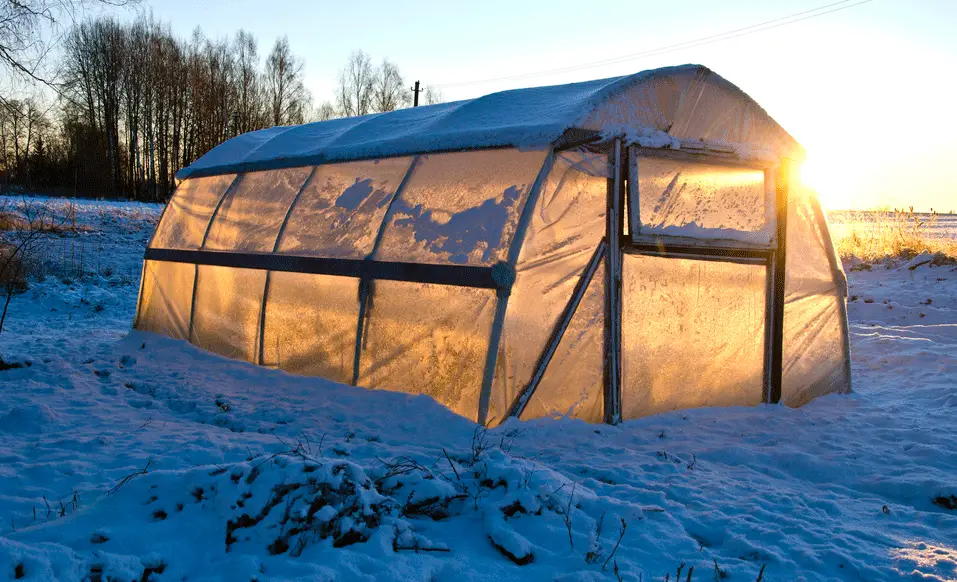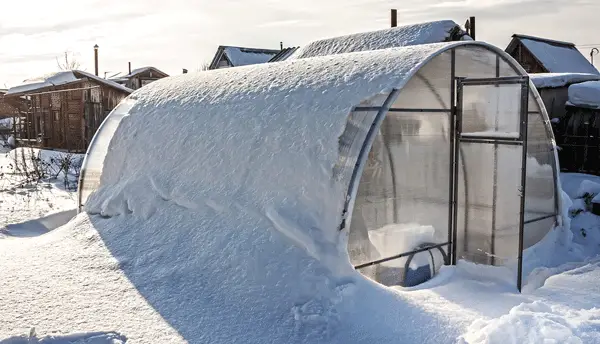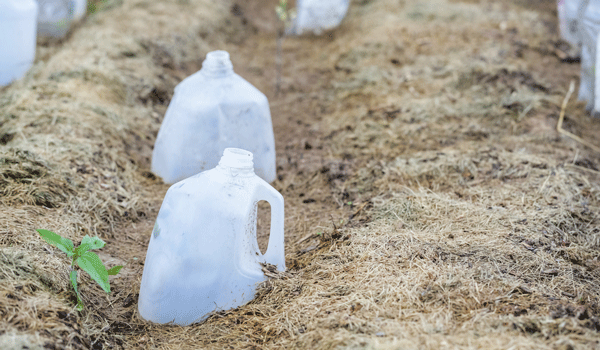How to Insulate A Greenhouse: 6 Ways To Heat Your Plants During Cold Spells

This post follows our research editorial guidelines.

The winter months are trying times for plants and gardeners alike. It’s sad to say, but this is when you have to take a hard look at your crop and determine what can survive and what needs to be pulled to make room for cool season crops. Luckily having your plants is a greenhouse creates a buffer of temperature from inside to outside allowing for tender plants to stay warm and even thrive while others are beginning to kick the bucket.

Table of Contents
Adjusting the light levels, humidity, and temperature can create favorable conditions in a greenhouse to suit plant requirements. As the food and Agricultural department of the UN puts it:
There are two main ways to increase greenhouse energy efficiency: reduce the energy input into the greenhouse system and increase production per unit of energy.
Food and Agricultural Organization of the United Nations
The temperature inside the greenhouse tends to be about 2-3 degrees C more than the outdoor temperatures, which isn’t an issue during mild frost. The trouble arises when the mercury dips drastically, making it hard for most plants to survive.
A standard solution is using a greenhouse heater to maintain a warm, suitable plant environment. However, with greenhouse insulation, you’ll be able to cut down your electricity bill (heating costs) and attain a 5-6 degrees C higher temperature inside.
This is ideal for most circumstances except for extreme weather conditions.
I’ll tell you about several techniques to insulate a greenhouse. You’ll need to figure out how much area you want to keep warm and insulate accordingly.
Polycarbonate Sheets
This method of greenhouse insulation has been gaining popularity owing to its vast benefits. It can also be used for sidewalls and roofs, built with air pockets with the utilization of hollow multi walls.
A higher insulation factor is achieved with air inside the panels.
While going with polycarbonate sheets, a higher R-value (insulating capability) and lower K-value (thermal conductivity) result in increased insulation.
Pros
- Lightweight, flexible, and virtually unbreakable
- UV-resistant
- Effective in temperatures of 284 degrees F and even below -40 degrees F
- Polycarbonate naturally traps radiation.
- Triple-walled polycarbonate sheeting provides superior strength and good heat retention.
- Thin-walled panels are durable and offer light diffusion and decent insulation.
- Thicker sheets improve thermal insulation by almost 30%.
Cons
- Thicker polycarbonate sheets decrease light transmission by almost 10%.
- Polycarbonate materials impact the environment. They don’t degrade, and the production creates a huge carbon footprint.
- Expensive to produce

Check for Loose Seals
It is vital to ensure your greenhouse has an airtight seal to keep the warmth confined for nighttime insulation and prevent any nocturnal creatures from entering.
Believe me, cold air and wind can creep in through the tiniest gaps in a frame.
Any gaps between the frame and panels could result in heat loss and let drafts in. Your greenhouse windows need to be checked periodically to ensure they close securely.
Typically, silicone sealants or rubber seals can be used for retaining heat. Silicone sealants are an excellent permanent solution. Filling in the corner cracks of the frame with silicone sealant keeps drafts out.
Use glazing strips or rubber seals for doors, vents, and windows.
Regular maintenance of your greenhouse seals will prevent heat from escaping. Panels, gaps, and holes must be checked and repaired once or twice a year. Door and window seals must be inspected each season, as they tend to wear out with weather changes and use.
As cumbersome as it may seem, it gives you long-lasting effects. I’ve personally experienced it with my greenhouse; a little effort goes a long way.
Pros
- Good seals help retain heat inside the greenhouse.
- There are inexpensive ways to seal off air gaps.
- Properly sealed windows and doors prevent drafts from entering the greenhouse.
- Pests and nocturnal creatures can be kept away with effective sealing.
Cons
- Difficult to keep track of cracks, holes, or other air gaps in a large greenhouse
- First-time sealing or maintaining/repairing existing seals could be time-consuming.
- It is possible to miss tiny air gaps during a maintenance inspection.
- Glazing clips could pop off, causing panes to blow outwards.

Adding An Extra Layer of Insulation Using Bubble Wrap in Your Greenhouse
The packaging wrap that you might like to sit and pop for fun actually helps insulate a greenhouse! A standard and inexpensive way of good greenhouse insulation is bubble plastic.
Regular packaging wrap isn’t as efficient as horticultural bubble wrap, which is tougher and lasts at least 3 years. It works well for double glazing, reducing the rate of heat escape and sealing off air gaps.
To put up bubble wrap, you’ll need to measure the size of the glass panes, cut the material to the required size, and fix it using strong tape.
For aluminum frames, use greenhouse clips that clip into the channels of the glazing bars to hold the wrap. A staple gun or drawing pins will suffice if you have a wooden greenhouse frame. It would be ideal to leave the greenhouse roof to allow sufficient light.
Bubble wrap with larger bubbles lets more light through and helps retain heat better.
Pros
- Inexpensive
- Easily available
- Efficient insulation material
- Prevents draughts
- Easy to install
- Tough and UV stabilized
- Increases temperature inside the greenhouse by 1-2 degrees
- You can divide and insulate only a part of the greenhouse instead of a complete insulation
Cons
- At times, bubble wrap may block light transmission.
- Needs to be replaced every few seasons
- Not environment-friendly as it is plastic
- Once wrapped, access to vents and windows is lost, leading to no air circulation and moisture build-up.
Setting A Good Foundation for Heat Loss
Often an overlooked factor, greenhouse foundations play an essential role in proper insulation. The outside ground freezes and enters the greenhouse through the ground foundation with frosty temperatures. Up to 15% of heat loss occurs through the ground.
Avoid setting up greenhouse insulation of concrete/cement or wood as it leads to poor insulation. Instead, dirt, gravel, or peat rock are better options.
Using a pocket of insulating soil along the perimeter of your greenhouse helps with ground insulation. Also, using styrofoam board or foam arranged to reach vertically down to about a foot can insulate a greenhouse’s outdoor border.
Any ground covering must be appropriately tucked on all the ends.
Pros
- Helps retain heat within the greenhouse
- Protects crops planted in the ground or greenhouses with raised beds
- Inexpensive techniques for foundation insulation
- Prevents heat loss to the surrounding topsoil
Cons
- If not installed properly, even a few uninsulated yards around the edges can impact negatively.

Thermal Mass Using Jugs
Apart from insulating your greenhouse, you could provide your plants with extra protection and heat. This can be done by filling hot water into empty jugs and keeping them next to your plants.
For this, empty one-gallon jugs will need to be painted black. This ensures water is kept hot for extended periods. After filling the jugs with hot water, a tablespoon of bleach needs to be mixed in to prevent mold formation in the jugs.
A word of caution here: keep your bottles labeled to avoid accidentally watering your plants with them.
Placing the jugs in the plant pots and around the base amplifies the heat from the sun’s rays, keeping your plants warm. The heat gets absorbed by the water in the daytime, releasing heat at night.
Pros
- Cheap and easy way of providing heat to greenhouse plants
- Keeps the greenhouse above freezing temperatures
Cons
- One-gallon jugs aren’t entirely efficient since they don’t heat a greenhouse rapidly.
- Using larger jugs (like 55-gallon jugs) is expensive.
Reflective Insulation
Considerable heat loss occurs in winter due to radiant heat transfer over free spaces.
Reflective insulation, a barrier typically made of aluminum foil or aluminized polyester, blocks the heat gained during the day inside your greenhouse.
Usually, 3/4th inch airspace is required while placing the reflective insulation material. This gives the insulating sheets space to sag along the surface, forming little pockets for proper reflection and deflection.
Pros
- Helps reduce energy costs
- Blocks 95% of radiant heat, providing superior thermal performance
- It doesn’t degrade over time.
- It’s thin, lightweight, and less bulky, making for easy installation.
- Can be used as a vapor barrier since it’s waterproof and not affected by moisture
Cons
- If not installed properly, it takes heat away through convection
- Needs to be combined with other insulation forms in winters to prevent heat loss from convection
- Generally more expensive
- Since it needs to be kept clean and dust- and debris-free for maximum efficiency, regular cleaning is needed

Thermal Insulation Foil
Thermal insulation foil is particularly useful for reflective insulation, which is 2 layers of silver foil with bubble plastic.
It efficiently reflects light and heat within the greenhouse, helping insulate it. However, using insulation foil on the north side of the greenhouse allows heat and light to be reflected more effectively.
By placing the thermal foil on the inside of the greenhouse roof, heat can be retained for longer periods.
Insulating wall areas of the greenhouse (those not important for sunlight) results in considerable heat saving. The more heat you can retain, the better.
Once you’ve cleaned the windows thoroughly, the foil can be attached to the north side of the greenhouse using greenhouse clips, tape, or staples. You could measure the area you intend to cover and cut the foil to the required length.
When coupled with another heating method, greenhouse insulation is more efficient.
Pros
- Prevents bugs, mold, rodents, and mildew
- An efficient way to maintain BTUs
- Easily available
- Easy to install
Cons
- Might prevent sufficient light from reaching your plants
- Needs to be promptly removed during the day to let sunlight in
- Slightly expensive
Alternative Ways
To Insulate Your Greenhouse
There are a few additional ways to ensure greenhouse insulation.
- For night-time insulation of your greenhouse, thermal blinds and screens could be used. Alternatively, you could cover your plants with layers of cover fabric, including blankets suspended on hoops or canes.
- Plants could be placed inside cloches and cold frames for extra protection.
- You could use empty plastic bottles with the bottom cut out and placed over plants to serve as mini cloches.
- Snow has insulating properties. If there’s been a heavy snowfall, the blanket of snow could help in insulation. However, you’ll need to clear off the sun-facing side of the roof to let in sunlight.
To Heat Your Greenhouse
I know I’ve been stressing only about keeping your greenhouse insulated so far, but there are other simple ways to heat it too.
- Build a separate composting area or chamber by stacking bricks or cement blocks in your greenhouse. When scraps in the compost pile break down, microbes give off heat, helping keep the greenhouse warm.
- Heat lamps kept plugged around the greenhouse keep plants warm in the winter. These can be hung or placed on the ground.
- Space heaters are an effective yet pricey way to keep the greenhouse warm.
Final Thoughts
Adding insulation to your greenhouse is as essential as using a heating device to heat it during winter.
Using both in conjunction provides the maximum benefit. There are several benefits to greenhouse insulation, including saving heating costs and providing your precious plants with much-needed warmth.
With insulation, the warm air is kept enclosed inside, which will help the plants thrive all year round.
